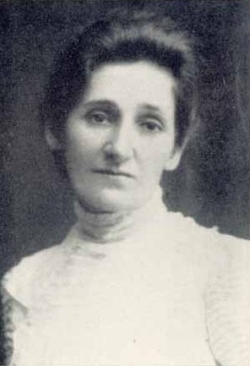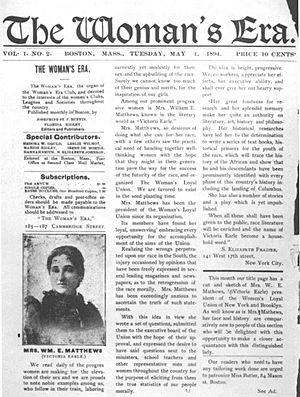Victoria Earle Matthews facts for kids
Quick facts for kids
Victoria Earle Matthews
|
|
|---|---|
 |
|
| Born |
Ella Victoria Smith
May 27, 1861 Fort Valley, Georgia, U.S.
|
| Died | March 10, 1907 (aged 45) New York City, U.S.
|
| Nationality | American |
| Occupation | Writer, activist |
Victoria Earle Matthews (born Ella Victoria Smith, May 27, 1861 – March 10, 1907) was an American writer, journalist, and activist. She was born into slavery in Fort Valley, Georgia. After slavery ended, she moved to New York City with her family. There, she went to school for a short time and worked to help her family.
As an adult, Matthews became involved in women's clubs and social work. In 1897, she started the White Rose Industrial Home for Working Class Negro Girls. This was a special place, also known as the White Rose Mission. It was a settlement house that offered safe housing, education, and job skills to young Black women.
Contents
Her Life Story
Victoria Earle was born into slavery on May 27, 1861, in Fort Valley, Georgia. This was just before the start of the American Civil War. Her mother, Caroline Smith, escaped from slavery soon after Victoria was born. She left Victoria and her eight brothers and sisters behind.
When her mother reached New York, she worked hard to earn money. She wanted to buy freedom for herself and her children. Caroline Smith fought a legal battle to get her daughters back. She was the first Black woman to be recognized in Georgia's court system.
Matthews, her mother, and her sister, Anna, traveled from Georgia. They went through Richmond and Norfolk, Virginia. Finally, they arrived in New York City in 1873. In New York, Victoria went to public school for only four years. Family problems forced her to leave school and work as a domestic servant.
She was lucky because her employer had a large home library. The owner saw Victoria reading and gave her permission to read whenever she had free time. Victoria worked extra hard to finish her tasks early so she could read and learn. A newspaper called The New York Freeman described Matthews as "ever ready and obliging."
On October 22, 1879, when she was eighteen, Victoria Smith married William E. Matthews. He was a coachman from Petersburg, Virginia. They had one son named Lamartine. Sadly, he passed away on September 19, 1895, at the age of sixteen. Victoria Earle Matthews died on March 10, 1907, at forty-five years old, from tuberculosis.
Her Work
Victoria Earle Matthews started her career as a journalist in 1887. The Washington Bee newspaper called her "the foremost of her sex of our race." This meant she was seen as a leading Black woman journalist.
Her Activism

Fighting for Civil Rights
In the early 1890s, Matthews became more involved in Black political and social groups. On October 5, 1892, Victoria Earle Matthews and activist Maritcha Remond Lyons organized a special dinner. It was held in New York's Lyric Hall for Ida B. Wells. Wells was leading a campaign against lynching, which was a terrible form of violence.
This event led to the creation of the Woman's Loyal Union of New York and Brooklyn. Matthews became the first president of this group, called the Woman's Loyal Union (WLU). The WLU was a civil rights organization. It worked to fight against unfair treatment based on race. It also supported Ida B. Wells's efforts to stop lynching.
In 1896, Matthews was the chairman of the executive board for the National Association of Colored Women. She often gave speeches about important issues of her time. Some of her most famous speeches were “The Value of Race Literature,” “The Role of Afro-American Women,” and "The Awakening of the Afro-American Woman" (1897). Her speeches encouraged race pride and self-worth among Black people.
Helping the Community
After her 16-year-old son, Lamartine, passed away, Matthews wanted to help young people. She traveled to the South to see what was being done for Black education. She became involved in "settlement work." This was a new type of social work started by women in big cities. A minister convinced her to return to New York.
Matthews began visiting families who needed help. She went from house to house, offering practical services. For example, she would help a busy mother prepare a meal or do laundry. Matthews learned that life for Black Americans was very hard. They faced "limited job chances, poor housing, poverty, prejudice, and violence based on race."
At this time, thousands of young Black people were moving to New York. This was part of the Great Migration. They hoped to find better jobs and opportunities than in the Jim Crow South. Matthews believed that young women needed a safe place to stay. They also needed to learn job skills to find work.
On February 11, 1897, Matthews and her supporters opened a place for young Black girls. It was called the White Rose Industrial Home for Working Class Negro Girls. A kind helper named Winthrop Phelps offered a flat in his building to start. Matthews arranged for the girls to learn sewing, dressmaking, and other skills for jobs. She also valued education and taught classes in math, reading, and writing. She even taught her students about Black history and literature. She kept a collection of books on Black history for everyone to use.
Matthews and her supporters realized that young women arriving in the city were at risk. They decided to create a place that offered housing. Volunteers would also meet new arrivals at train stations to offer them safe housing. They bought a house at 217 East 86th Street. This became the White Rose Home for Working Class Negro Girls, or the White Rose Mission. Matthews encouraged the girls to live with purity and goodness.
To support the mission, she gained help from important Black ministers. One was Adam Clayton Powell, Sr., pastor of the Abyssinian Baptist Church. He became a trustee of the mission.
Matthews was proud of her race. She wanted to inspire people by giving them useful skills. She believed that with self-sufficiency, they could have noble thoughts and great ideas. Matthews and her volunteers taught young women skills like sewing, hat-making, and cooking. This helped the young women get decent jobs, even if they didn't pay much.
The White Rose Industrial Home allowed students to live with their teachers. They learned from each other in daily life and had protection. The White Rose Home also offered specific education and fun social activities. The mission provided recreation, literary events, and classes on Black history.
Matthews was also on the board of directors for McDonough Memorial Dispensary. This was a hospital that would serve Black people and people of all backgrounds.
Her Writings
Victoria Earle Matthews wrote short stories. She focused on showing the challenges faced by Black people, especially Black women. Her stories often featured kind Black female main characters. These characters dealt with issues like colorism and learned to be proud of their Black identity.
- 1893. Aunt Lindy: A Story Founded on Real Life
- 1892. Eugenie's Mistake: A Story
- 1892. Zelika- A Story
Her Legacy
The all-Black Victoria Earle Matthews (Mothers) Club was named after her. This club helped girls and women who had been treated badly or were in danger. Victoria Earle Matthews is also seen by some as the first Black social worker in New York. She was a pioneer for the social welfare system we have today. Matthews is remembered with a plaque that says "The White Rose Home." It is on the brownstone building where she lived in Brooklyn, at 33 Poplar Street.
Images for kids



